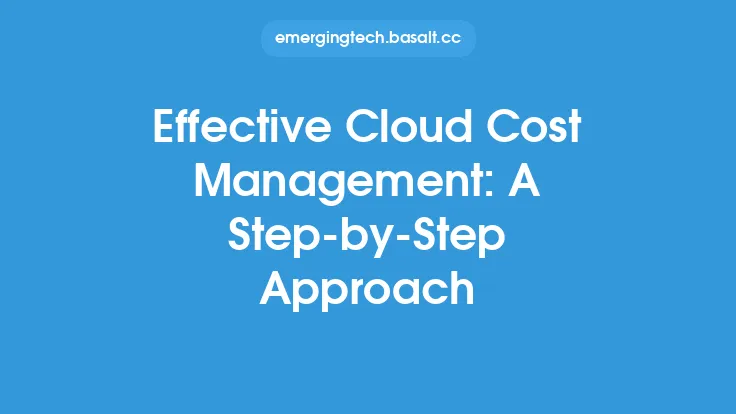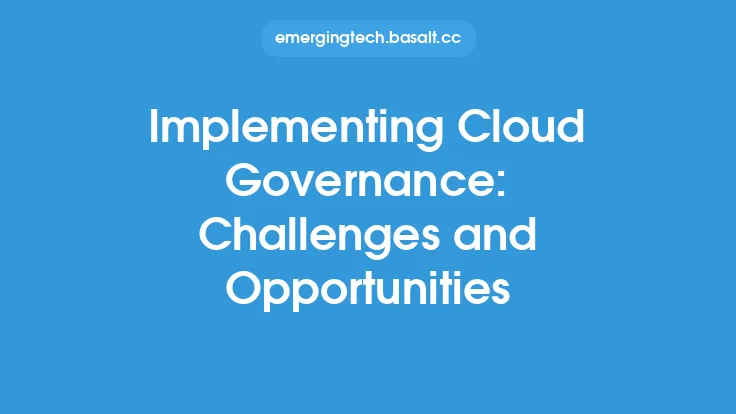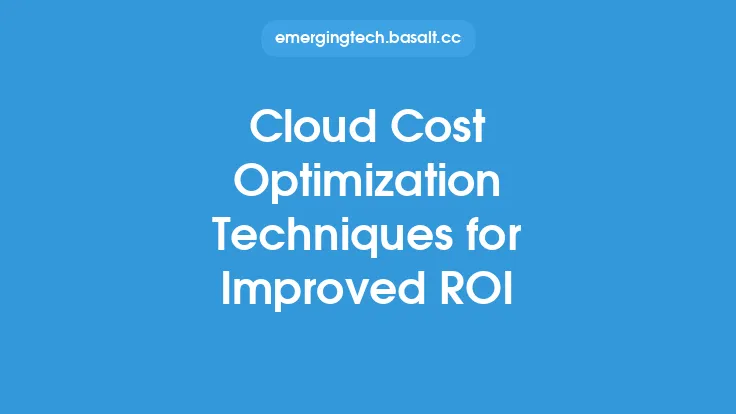Implementing a cloud cost governance framework is a crucial step for organizations to ensure they are getting the most out of their cloud investments while minimizing waste and optimizing resources. A well-designed framework provides a structured approach to managing cloud costs, ensuring that all stakeholders are aligned and working towards common goals. In this article, we will delve into the key components of a cloud cost governance framework, best practices for implementation, and the benefits of having a robust framework in place.
Introduction to Cloud Cost Governance
Cloud cost governance refers to the set of policies, procedures, and tools used to manage and optimize cloud costs within an organization. It involves establishing clear guidelines and standards for cloud resource usage, monitoring and reporting on cloud costs, and implementing controls to prevent waste and ensure cost-effectiveness. A cloud cost governance framework provides a structured approach to managing cloud costs, ensuring that all stakeholders are aligned and working towards common goals.
Key Components of a Cloud Cost Governance Framework
A cloud cost governance framework typically consists of several key components, including:
- Cloud Cost Policy: A clear and concise policy that outlines the organization's cloud cost management goals, objectives, and guidelines.
- Cloud Cost Monitoring and Reporting: A system for tracking and reporting on cloud costs, including usage, spend, and performance metrics.
- Cloud Resource Management: A set of processes and tools for managing cloud resources, including provisioning, de-provisioning, and rightsizing.
- Cloud Cost Optimization: A set of strategies and techniques for optimizing cloud costs, including reserved instances, spot instances, and automated scaling.
- Cloud Cost Governance Team: A cross-functional team responsible for implementing and enforcing the cloud cost governance framework.
Best Practices for Implementing a Cloud Cost Governance Framework
Implementing a cloud cost governance framework requires careful planning, execution, and ongoing monitoring. Here are some best practices to consider:
- Establish Clear Goals and Objectives: Define clear goals and objectives for cloud cost management, including target cost savings and performance metrics.
- Develop a Comprehensive Cloud Cost Policy: Develop a comprehensive cloud cost policy that outlines guidelines for cloud resource usage, monitoring, and reporting.
- Implement Cloud Cost Monitoring and Reporting: Implement a cloud cost monitoring and reporting system that provides real-time visibility into cloud costs and usage.
- Automate Cloud Resource Management: Automate cloud resource management using tools and scripts to streamline provisioning, de-provisioning, and rightsizing.
- Provide Training and Education: Provide training and education to stakeholders on cloud cost governance best practices and policies.
Benefits of a Cloud Cost Governance Framework
A well-designed cloud cost governance framework provides numerous benefits, including:
- Improved Cost Visibility: Real-time visibility into cloud costs and usage, enabling better decision-making and cost optimization.
- Increased Cost Savings: Identification and elimination of waste, reserved instances, and spot instances, resulting in significant cost savings.
- Enhanced Performance: Optimized cloud resource utilization, resulting in improved performance and reduced latency.
- Better Risk Management: Reduced risk of cloud cost overruns, security breaches, and compliance issues.
- Improved Collaboration: Cross-functional collaboration and alignment among stakeholders, ensuring that all teams are working towards common goals.
Technical Considerations for Cloud Cost Governance
From a technical perspective, implementing a cloud cost governance framework requires consideration of several key factors, including:
- Cloud Provider APIs: Integration with cloud provider APIs, such as AWS CloudWatch, Azure Cost Estimator, and Google Cloud Cost Estimator, to collect usage and cost data.
- Cloud Cost Monitoring Tools: Utilization of cloud cost monitoring tools, such as Cloudability, ParkMyCloud, and Turbonomic, to track and report on cloud costs.
- Automation and Scripting: Automation of cloud resource management using scripts and tools, such as AWS CloudFormation, Azure Resource Manager, and Google Cloud Deployment Manager.
- Cloud Security and Compliance: Implementation of cloud security and compliance controls, such as IAM policies, access controls, and encryption, to ensure the security and integrity of cloud resources.
Conclusion
Implementing a cloud cost governance framework is a critical step for organizations to ensure they are getting the most out of their cloud investments while minimizing waste and optimizing resources. By establishing clear policies, monitoring and reporting on cloud costs, and implementing controls to prevent waste, organizations can achieve significant cost savings, improved performance, and better risk management. By following best practices and considering technical factors, organizations can ensure a successful implementation of a cloud cost governance framework and achieve their cloud cost management goals.





